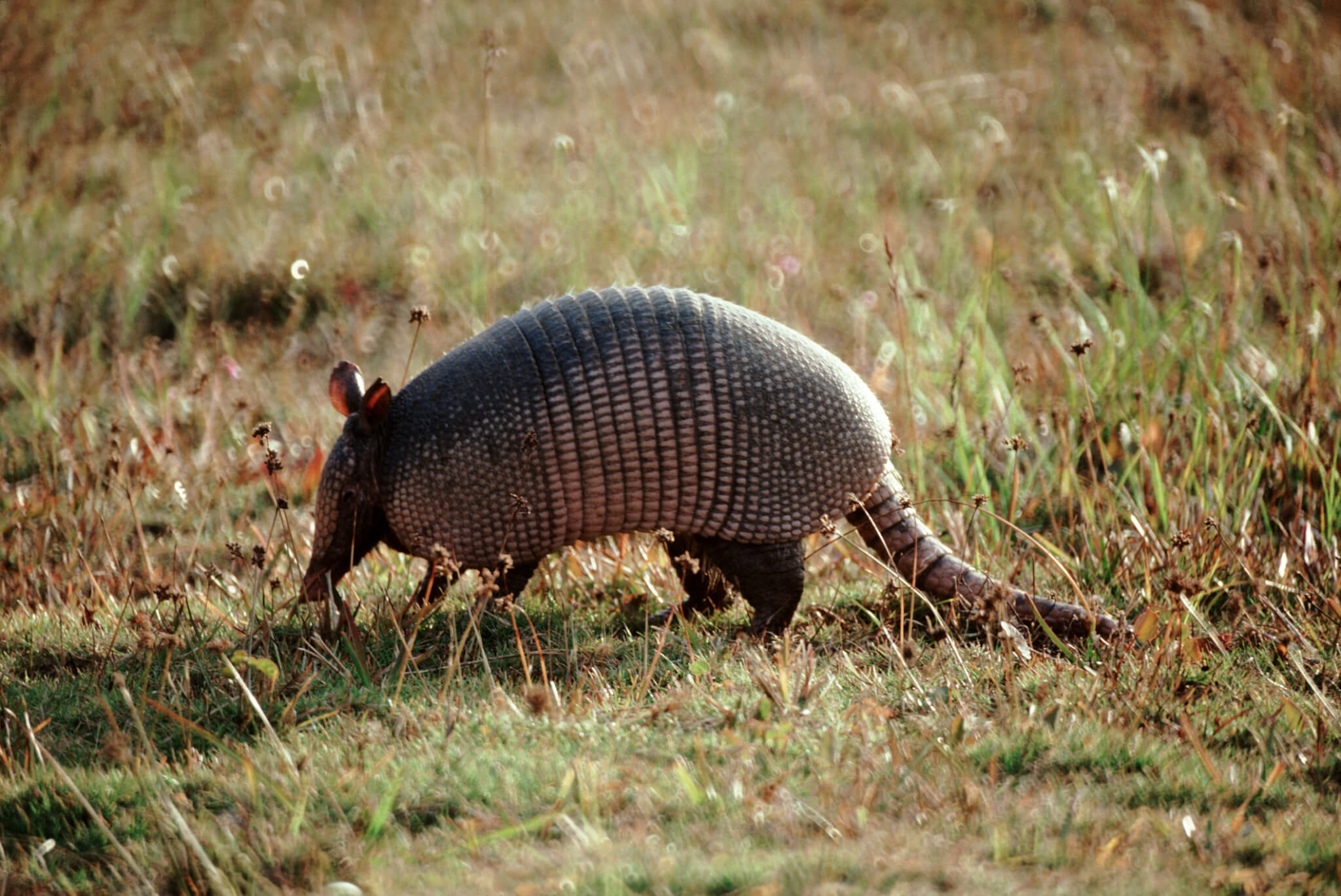
Roy Morsch/Getty Images
Yes, Virginia. There are armadillos here. The little armored critter made its way to Virginia’s mountains in 2019.
If great-grandpa starts telling tales at your holiday gathering about a sighting of a little armored creature, you might assume he had a little too much eggnog.
In actuality, it’s totally possible that he saw an armadillo. Yes, in Virginia.
The Eastward Expansion
Between the mid-1800s and early 1900s, armadillos started moving eastward from Texas. The small mammal likely became a stowaway, which helped it cross a major barrier.
“[Researchers think that] some armadillos got on some cattle railcars and made it across the Mississippi River—which was a big deal because otherwise, you know, how do you get across such a wide river?” said Dr. Nancy Moncrief, curator of mammalogy at the Virginia Museum of Natural History in Martinsville.
Since then, armadillos started their slow and steady eastward expansion, along with some human help, speeding up the process.
“By the 1930s, 1940s, there were people with roadside carnivals in Florida who had armadillos as sort of a curiosity,” Moncrief said. “Somehow they either let them go or they got loose. And because [in] Florida the climate is similar to South Texas, they did just fine.”
Armadillos In Our Area
If you’re thinking armadillos only roll with tumbleweeds or sunbathe at the ocean, think again. Following the Mississippi River crossing and Florida fiasco, armadillos started moving north.
“Initially, humans kind of transported them, but eventually, they started moving themselves,” Moncrief said.
In 2007, the North Carolina Wildlife Resources Commission confirmed the first armadillo sighting in the state. Since then, their numbers grew exponentially. The commission received 440 reports over 14 years.
So how about Virginia?
“There were some sporadic reports of [armadillos] before 2013 that were roadkill and may have either been intentionally or accidentally brought into Virginia on some kind of vehicle,” Moncrief said.
That all changed in 2019 when the first verified records of live, free-ranging armadillos in Virginia occurred, which Moncief and other researchers documented and studied. From the first account through 2020, five sightings occurred in the commonwealth’s southwestern region. The first happened in Buchanan County, the second and third sightings occurred in Russell County. The fourth was in Washington County, while the fifth was spotted in Wythe County. An additional three sightings took place in bordering Kentucky and Tennessee counties.
“You don’t think of these as mountain animals at all,” Moncrief said. “I guess I was surprised that they were in western Virginia before we saw them in eastern Virginia because when I started looking at this, there’ve been lots of reports in eastern North Carolina, like on the coastal plain. I always think of them as being coastal animals, like the sandy soil in Florida, Louisiana, and Texas.”
As for when they’ll move to other parts of the commonwealth, Moncrief predicted a northward expansion before an eastward one.
“We think that they have built up their populations enough in Tennessee that they’re starting to move on up into western Virginia along the Upper Clinch [Watershed] and the Holston [River Watershed],” Moncrief said. “They may continue moving up into western Virginia, but we’re going to start seeing them in eastern Virginia coming up from eastern North Carolina before they start moving from western Virginia to eastern Virginia.”
Are Armadillos a Threat?
While armadillos aren’t native to Virginia, they don’t pose an inherent threat to most species. That is, of course, unless you’re an insect or a landscaper—they do love eating bugs and grubs and digging up yards.
Like all mammals, armadillos can catch and carry rabies, but their risk is low. There’s another disease people sometimes associate with the animal—and that’s leprosy, also called Hansen’s disease. According to Smithsonian Magazine, only humans and armadillos can host the disease, which causes skin lesions and nerve damage.
Exercising proper precautions before handling a deceased Virginia armadillo as a museum specimen, Moncrief reached out to Dr. Linda Adams, chief of the National Hansen’s Disease Program’s Laboratory Research Branch in Louisiana. She inquired about the connection between leprosy and armadillos.
Through emailed correspondence, Adams noted that Mycobacterium leprae prefers cooler body temperatures, around 91F to 93F. In general, armadillo tissues have a core body temperature of around 93F. The threat of leprosy diminishes at a normal human body temperature, 98.6F.
While there are no known cases of armadillo-based leprosy in Virginia, the animal tested positive for the disease in Louisiana, Mississippi, Alabama, and Florida. According to Critter Control, most problems occur not at the fault of the armadillo, but because humans attempt to interact with the creature. Moncrief discouraged the action.
“I think in general just leaving wild animals to do their own thing is the best approach,” Moncrief said.
Support Our Cause
Thank you for taking the time to read our work. Before you go, we hope you'll consider supporting our values-driven journalism, which has always strived to make clear what's really at stake for Virginians and our future.
Since day one, our goal here at Dogwood has always been to empower people across the commonwealth with fact-based news and information. We believe that when people are armed with knowledge about what's happening in their local, state, and federal governments—including who is working on their behalf and who is actively trying to block efforts aimed at improving the daily lives of Virginia families—they will be inspired to become civically engaged.


VIDEO: Your support matters!
Your support matters! Donate today. @vadogwoodnews Your support matters! Visit our link in bio to donate today. #virginianews #virginia #community...

Op-Ed: Virginia’s new Democratic majorities pass key bills to improve your lives, but will Youngkin sign them?
The 2024 Virginia General Assembly regular session has wrapped up. It was a peculiar session from the outset, with Democratic majorities in the...

Op-Ed: Why Virginia Needs A Constitutional Amendment Protecting Reproductive Freedom
Virginia’s recent election season in 2023 drew in eyes from all over the country. Reproductive freedom was on the line and Virginia remained the...

From the state rock to the state flower, here’s how Virginia got its symbols
Have you ever wondered why the Dogwood is the state flower? Or how the cardinal became the state bird? We’re here to answer those questions and more...

VIDEO: Second-gentleman Douglas Emhoff gives speech on reproductive freedom
Second gentleman, Douglas Emhoff touched on reproductive freedom not only being a woman's issue but "an everyone's issue" during the Biden-Harris...

Glenn Youngkin and the terrible, horrible, no good, very bad night
Election Day 2023 has come and gone, and while there are votes to be counted, one thing is perfectly clear: Virginians unequivocally rejected Gov....





